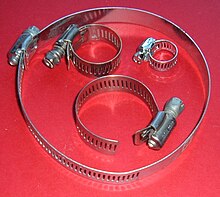Hose clamp
The core range of hose clamps on the open market are made from materials like stainless steel, which come in varying standards such as 304 (W4), 316 (W5) and 430 (W3).
Stainless steel is classified into various grades based on its composition and properties, which are crucial for applications such as hose clamps.
The clamp is put around the hose or tube to be connected, with the loose end being fed into a narrow space between the band and the captive screw.
The ends of these protrusions are then bent outwards, and the strip rolled to form a ring, with the protruding tabs intermeshing.
Spring clamps are particularly suited for confined or otherwise awkward places where other clip types would require tightening tools applied from narrow and possibly inaccessible angles.
This has made them particularly popular for applications such as automotive engine bays and for securing barb connections in PC water-cooling.
If closure of the clamp “ear(s)” is performed to manufacturer's recommendations, which generally provide for constant jaw force, the sealing effect is not unduly sensitive to component tolerance variations.
Such stepless clamps are claimed to be well suited to applications involving thin-walled hoses, supposedly with higher retained loads.
This suggests they should be considered for difficult to seal applications such as molded plastics or other less malleable materials, commonly used in the automotive industry.
Hose clamps are typically limited to moderate pressures, such as those found in automotive and home applications.
Hose clamps are frequently used for things other than their intended use, and are often used as a more permanent version of duct tape wherever a tightening band around something would be useful.
Some things seen assembled with hose clamps include the tail boom on a GMP Cricket model helicopter, a homemade gas scooter, makeshift pipe hangers, mounts for rooftop TV and shortwave antennas, and virtually every imaginable automobile body component.
To combat this, the more complicated and weaker design of having the ends overlap and then be pushed apart from each other is used, as this ensures pressure around the entire circumference of the hose.
To ensure a good seal, the barb, hose nipple, or beaded tube must be smooth and free of nicks, scratches, or contamination.
Within the United States, SAE International maintains Specification J1508[6] for thirty-two different hose clamp designs, including screw, spring, and t-bolt styles.




